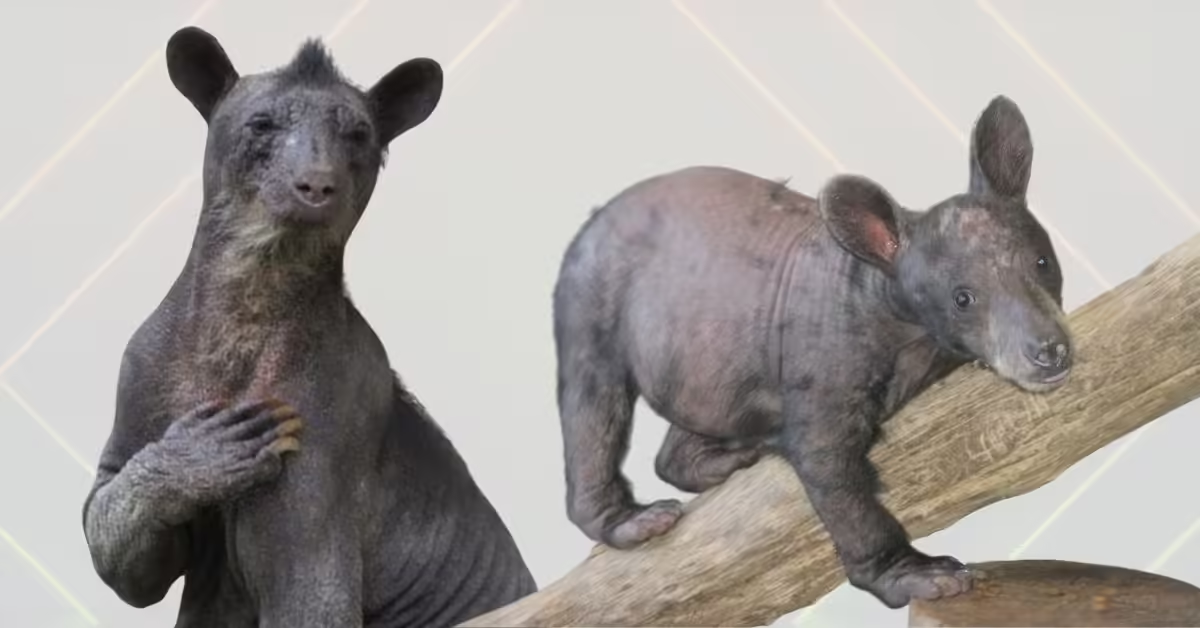What Is a Hairless Bear?
When people think of bears, they often imagine furry, majestic creatures that roam forests, mountains, or tundra. However, a hairless bear breaks this familiar image, presenting a surprising and sometimes alarming sight. A hairless bear is not a distinct species but a bear that has lost most or all of its fur due to skin diseases, genetic issues, or environmental stressors. This condition occurs across various bear species, from the mighty grizzly to the spectacled bear.
Hair loss in bears raises concerns for wildlife enthusiasts and researchers alike. Fur serves a critical function for bears—it provides insulation, protects against injuries, and helps regulate their body temperature. Without fur, bears face numerous challenges, including difficulty in surviving harsh climates. The term “hairless bear” gained popularity after viral photos of bald spectacled bears, particularly from zoos, sparked curiosity worldwide.
This blog explores the causes, treatment, and impact of fur loss in bears. It also highlights conservation efforts, fascinating recovery stories, and why studying this phenomenon is crucial for wildlife protection.
Why Do Bears Lose Their Fur?
Common Causes of Hair Loss in Bears
Hair loss in bears, scientifically known as alopecia, occurs due to various reasons, including:
- Mange: Mange, caused by microscopic mites, is a leading cause of baldness in bears. These parasites burrow into the skin, causing itching, irritation, and fur loss.
- Genetic Factors: Some spectacled bears in captivity have hereditary skin conditions, making them prone to fur loss.
- Nutritional Deficiencies: A poor diet, especially in zoos or degraded habitats, can result in fur shedding due to weakened immunity.
- Hormonal Imbalances: Conditions like hypothyroidism may trigger alopecia in bears.
Hair loss isn’t just a cosmetic issue. It often signals underlying health problems that can impact the bear’s overall survival and well-being. For instance, furless bears are more vulnerable to extreme weather, parasites, and injuries.
Notable Hairless Bears in Zoos
One of the most famous cases of a hairless spectacled bear is Dolores, a resident of Leipzig Zoo in Germany. Dolores lost almost all her fur due to a suspected genetic skin condition. Images of her hairless appearance went viral, sparking both fascination and concern. While zoos provided medical care, the genetic nature of the issue made a full recovery unlikely.
Another case involved bears in the USA battling mange. With proper treatment and nutritional support, some regained their fur over time. These cases underscore the importance of understanding and addressing the causes of hair loss in bears, particularly those in captivity.
Challenges Hairless Bears Face in the Wild
In the wild, a bear’s fur is its shield. Hairless bears face a daunting set of challenges:
- Temperature Regulation: Without fur, bears struggle to stay warm in cold climates or cool in hot environments.
- Increased Vulnerability: Hairless skin exposes bears to injuries, infections, and sunburn.
- Reduced Camouflage: Fur often helps bears blend into their environment, aiding in hunting and avoiding predators.
Wildlife researchers note that hairless bears often suffer from lower survival rates due to these vulnerabilities.
Can Hairless Bears Recover?
Recovery Stories and Treatment Options
Bears suffering from mange or mild skin issues often recover with proper care. Wildlife centers and zoos employ various treatments, including:
- Topical Treatments: Anti-parasitic creams and sprays combat mange and other skin infections.
- Dietary Improvements: Enriching a bear’s diet with vitamins and nutrients strengthens its immune system.
- Antibiotics and Medications: These help treat secondary bacterial infections caused by mange.
With timely intervention, many hairless bears regain their fur, though some genetic conditions remain irreversible.
Conservation and Research on Hairless Bears
Organizations like wildlife sanctuaries and research centers play a critical role in studying and aiding bald bears. By tracking cases of fur loss, they help identify patterns, improve treatment protocols, and educate the public.
Myths and Misconceptions About Hairless Bears
Viral photos of bald bears often spark sensational headlines and myths. Some claim they are cryptids or hybrid species. In reality, these are regular bears suffering from treatable conditions.
Protecting Bears From Fur Loss
Preservation Efforts
- Educating communities about diseases like mange.
- Reducing deforestation, which disrupts habitats.
Conclusion
Hairless bears remind us how delicate wildlife health can be. From genetic issues to treatable diseases, their stories underline the importance of conservation and care.
FAQs
- What causes hair loss in bears? Mange, genetics, and poor nutrition are common causes.
- Can hairless bears survive in the wild? They face challenges but can survive with intervention.
- Do hairless bears regrow their fur? Many recover with proper treatment.
- Is mange contagious among animals? Yes, mange can spread to other wildlife.
- How do zoos help hairless bears? By providing medical care and balanced diets.
Philip John is the dedicated admin of My Read Magazine, ensuring every article meets the highest standards before publication. With years of editorial experience, he carefully reviews each piece for accuracy, clarity, and relevance. His commitment to quality helps maintain the magazine’s reputation as a trusted and reliable source of information for readers worldwide.




